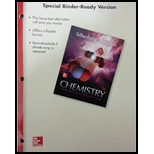
Concept explainers
(a)
Interpretation:
The number of moles and number of ions of each type in
Concept introduction:
Molarity
The expression to calculate the moles of the compound when molarity of solution and volume of solution are given is as follows:
The expression to calculate the moles of ions is as follows:
The expression to calculate the number of ions is as follows:
(a)
Answer to Problem 4.26P
The number of moles of is
Explanation of Solution
The expression to calculate the moles of aluminium chloride is:
The relation between
Substitute
One mole of aluminium chloride
The expression to calculate the amount of
Substitute
The expression to calculate the number of
Substitute
The expression to calculate the amount of
Substitute
The expression to calculate the number of
Substitute
The number of moles of is
(b)
Interpretation:
The number of moles and number of ions of each type in
Concept introduction:
Molarity
The expression to calculate the moles of solute when given mass and molecular mass of compound are given is as follows:
The expression to calculate the moles of ions is as follows:
The expression to calculate the number of ions is as follows:
(b)
Answer to Problem 4.26P
The number of moles of is
Explanation of Solution
The molecular mass of lithium sulphate
The expression to calculate the moles of lithium sulphate
Substitute
One mole of lithium sulphate
The expression to calculate the amount of
Substitute
The expression to calculate the number of
Substitute
The expression to calculate the amount of
Substitute
The expression to calculate the number of
Substitute
The number of moles of is
(c)
Interpretation:
The number of moles and number of ions of each type in
Concept introduction:
A formula unit is used for the ionic compound to represent their empirical formula. The expression to calculate the moles of a compound when the volume of solution and formula unit of a compound is given is as follows:
The expression to calculate the moles of ions is as follows:
The expression to calculate the number of ions is as follows:
(c)
Answer to Problem 4.26P
The number of moles of is
Explanation of Solution
One mole of potassium bromide
The expression to calculate the moles of
Substitute
The expression to calculate the amount of
Substitute
The expression to calculate the number of
Substitute
The expression to calculate the amount of
Substitute
The expression to calculate the number of
Substitute
The number of moles of is
Want to see more full solutions like this?
Chapter 4 Solutions
Chemistry: The Molecular Nature of Matter and Change (Looseleaf)
- Assign ALL signals for the proton and carbon NMR spectra on the following pages.arrow_forward7.5 1.93 2.05 C B A 4 3 5 The Joh. 9 7 8 1 2 7.5 7.0 6.5 6.0 5.5 5.0 4.5 4.0 3.5 3.0 2.5 2.0 1.5 1.0 ppm 9 7 8 0.86 OH 10 4 3 5 1 2 7.5 7.0 6.5 6.0 5.5 5.0 4.5 4.0 3.5 3.0 2.5 2.0 1.5 1.0 ppm 9 7 8 CI 4 3 5 1 2 7.0 6.5 6.0 5.5 5.0 4.5 4.0 3.5 3.0 2.5 2.0 2.21 4.00 1.5 2.00 2.07 1.0 ppm 2.76arrow_forwardAssign the functional group bands on the IR spectra.arrow_forward
- Find the pH of a 0.120 M solution of HNO2. Find the pH ignoring activity effects (i.e., the normal way). Find the pH in a solution of 0.050 M NaCl, including activityarrow_forwardPlease help me answer these three questions. Required info should be in data table.arrow_forwardDraw the major organic substitution product or products for (2R,3S)-2-bromo-3-methylpentane reacting with the given nucleophile. Clearly drawn the stereochemistry, including a wedged bond, a dashed bond and two in-plane bonds at each stereogenic center. Omit any byproducts. Bri CH3CH2O- (conc.) Draw the major organic product or products.arrow_forward
- Tartaric acid (C4H6O6) is a diprotic weak acid. A sample of 875 mg tartaric acid are dissolved in 100 mL water and titrated with 0.994 M NaOH. How many mL of NaOH are needed to reach the first equivalence point? How many mL of NaOH are needed to reach the second equivalence point?arrow_forwardIncluding activity, calculate the solubility of Pb(IO3)2 in a matrix of 0.020 M Mg(NO3)2.arrow_forwardIncluding activity coefficients, find [Hg22+] in saturated Hg2Br2 in 0.00100 M KBr.arrow_forward
- Including activity, calculate the pH of a 0.010 M HCl solution with an ionic strength of 0.10 M.arrow_forwardCan I please get the graph 1: Concentration vs. Density?arrow_forwardOrder the following series of compounds from highest to lowest reactivity to electrophilic aromatic substitution, explaining your answer: 2-nitrophenol, p-Toluidine, N-(4-methylphenyl)acetamide, 4-methylbenzonitrile, 4-(trifluoromethyl)benzonitrile.arrow_forward
 ChemistryChemistryISBN:9781305957404Author:Steven S. Zumdahl, Susan A. Zumdahl, Donald J. DeCostePublisher:Cengage Learning
ChemistryChemistryISBN:9781305957404Author:Steven S. Zumdahl, Susan A. Zumdahl, Donald J. DeCostePublisher:Cengage Learning ChemistryChemistryISBN:9781259911156Author:Raymond Chang Dr., Jason Overby ProfessorPublisher:McGraw-Hill Education
ChemistryChemistryISBN:9781259911156Author:Raymond Chang Dr., Jason Overby ProfessorPublisher:McGraw-Hill Education Principles of Instrumental AnalysisChemistryISBN:9781305577213Author:Douglas A. Skoog, F. James Holler, Stanley R. CrouchPublisher:Cengage Learning
Principles of Instrumental AnalysisChemistryISBN:9781305577213Author:Douglas A. Skoog, F. James Holler, Stanley R. CrouchPublisher:Cengage Learning Organic ChemistryChemistryISBN:9780078021558Author:Janice Gorzynski Smith Dr.Publisher:McGraw-Hill Education
Organic ChemistryChemistryISBN:9780078021558Author:Janice Gorzynski Smith Dr.Publisher:McGraw-Hill Education Chemistry: Principles and ReactionsChemistryISBN:9781305079373Author:William L. Masterton, Cecile N. HurleyPublisher:Cengage Learning
Chemistry: Principles and ReactionsChemistryISBN:9781305079373Author:William L. Masterton, Cecile N. HurleyPublisher:Cengage Learning Elementary Principles of Chemical Processes, Bind...ChemistryISBN:9781118431221Author:Richard M. Felder, Ronald W. Rousseau, Lisa G. BullardPublisher:WILEY
Elementary Principles of Chemical Processes, Bind...ChemistryISBN:9781118431221Author:Richard M. Felder, Ronald W. Rousseau, Lisa G. BullardPublisher:WILEY





